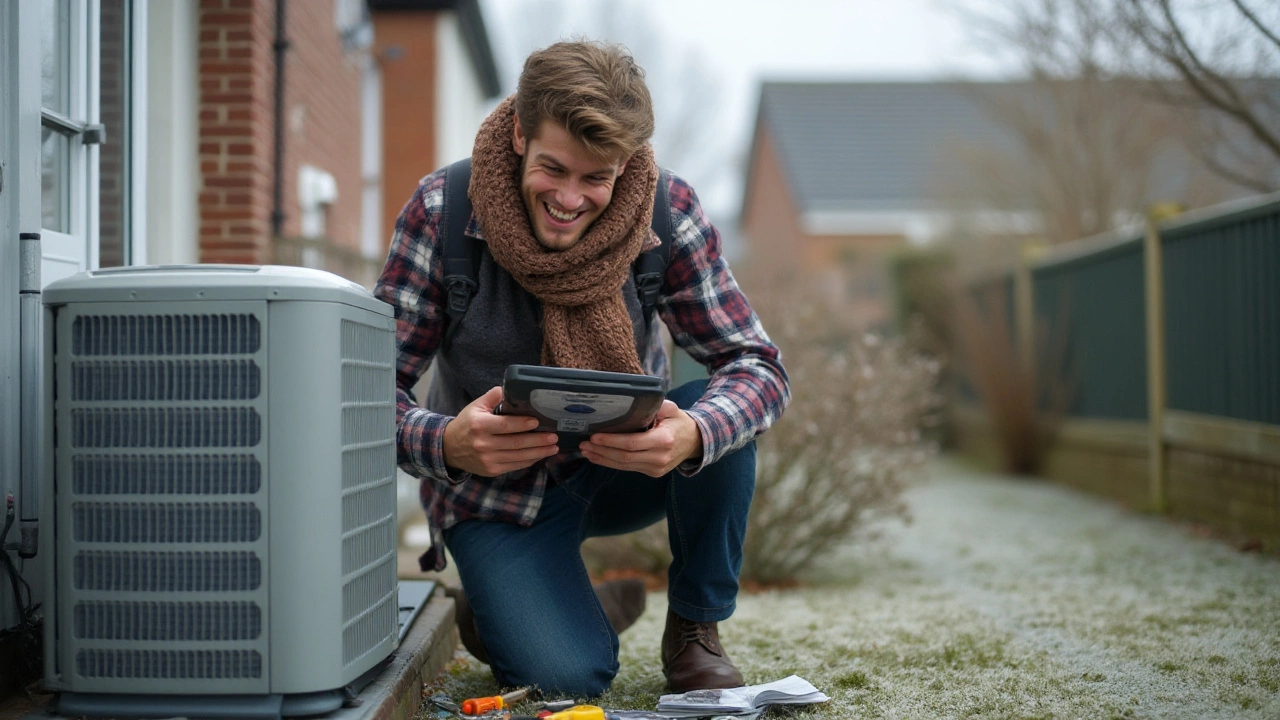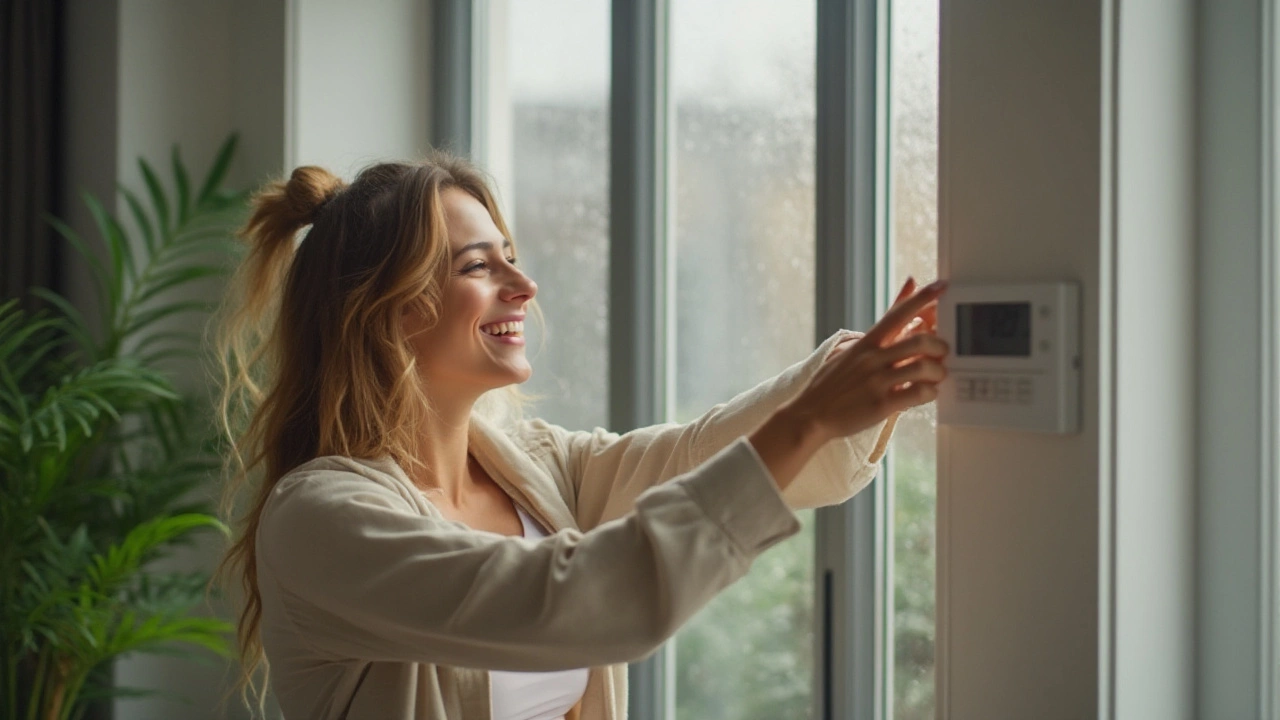If you've ever cranked up the thermostat only to feel a chilly breeze coming from your heat pump, you're not alone. A heat pump that isn't producing warm air can quickly turn a cozy home into an uncomfortable environment. The good news? Many of these issues boil down to a few common culprits that are easy to identify and, oftentimes, easy to fix.
In this article, we'll take a closer look at why your heat pump might not be blowing warm air. From simple fixes you can handle yourself to signs it's time to bring in the pros, you'll find valuable information to set things right. This is your guide to understanding the nuances of heat pump performance, ensuring you're prepared for the chilly days ahead.
- Understanding Heat Pump Basics
- Common Causes of Cold Air
- Simple Troubleshooting Steps
- When to Call a Professional
- Preventative Maintenance Tips
- Seasonal Usage and Efficiency
Understanding Heat Pump Basics
Heat pumps are fascinating devices designed to move heat from one place to another, and they're incredibly efficient in doing so. When it’s chilly outside, a heat pump draws heat from the outdoors and moves it inside your home, providing a cozy environment even when the temperatures dip. This might sound like magic, but it's pure thermodynamics at work, leveraging principles that have been around for centuries to keep us warm. Unlike traditional heating systems that generate heat by burning fuel, heat pumps use electricity to transfer heat, making them more energy-efficient and environmentally friendly. By reducing the need to consume fossil fuels directly, these systems help cut down greenhouse emissions — a win for your pocket and the planet.
The beauty of a heat pump lies in its dual purpose – it can also serve as a cooling system during warmer months, making it a versatile solution for homes. It reverses its operation by removing heat from inside the house and expelling it outside, essentially working like an air conditioner. This adaptability means investing in a heat pump can be cost-effective in climates with moderate heating and cooling needs. However, while they are high-performance machines, their efficiency can vary based on several factors, including outdoor temperature, the type of heat pump, and how well-maintained your system is. Regular maintenance is essential to ensure everything is running smoothly and to prevent common problems such as your heat pump not blowing warm air.
Understanding how a heat pump functions help us comprehend why things might go wrong. At its heart, a heat pump consists of components like the compressor, condenser, expansion valve, and evaporator, all working in tandem. These components manage the flow of refrigerant; this special fluid undergoes phase changes to absorb or release heat. Despite their robustness, these components require a delicate balance to function correctly, and even minor disruptions can affect performance. That’s why keeping an eye on regular maintenance checks, like ensuring refrigerant levels are adequate and filters are clean, can make all the difference.
Experts often emphasize understanding the kind of heat pump you have installed to better diagnose issues when they crop up. Commonly, you'll encounter air-source heat pumps, which draw heat from the air, and ground-source heat pumps that tap into the Earth's constant underground temperature. According to a recent report by the Department of Energy, over half of American homes are now considering heat pumps due to their efficiency. This trend suggests a growing awareness of their benefits and a collective shift towards sustainable energy solutions. While these systems are a boon for modern households, they need care and understanding to function best. As Albert Einstein once quipped, "The important thing is not to stop questioning. Curiosity has its own reason for existing." This rings true when it comes to maintaining our home energy systems.
Common Causes of Cold Air
When it seems like your heat pump is blowing only cold air, it might feel like you're caught in a frigid puzzle. The possible reasons behind this conundrum can range from minor adjustments to equipment issues requiring prompt attention. One of the most frequent causes is an incorrect thermostat setting. Sometimes, the thermostat might be accidentally set to 'cool' or the temperature setting is too low. Ensure your thermostat is set to heat mode, allowing the heat pump to do its job efficiently.
A clogged air filter is another usual suspect when it comes to cold air troubles. Over time, filters collect dust and debris, reducing airflow and potentially leading to inadequate heating. Replace or clean your filters regularly to maintain proper air flow and to ensure your system isn't overworking while delivering underwhelming results. With poor airflow, the system's balance is off, leading to less effective heating.
According to EnergyStar.gov, "Regular maintenance of your heating system, including changing air filters, is one of the most effective measures for keeping your system efficient and improving indoor air quality."
Another common yet often overlooked cause is low refrigerant levels. Refrigerant plays a crucial role in the heat pump's performance. If there’s a leak or the fluid needs refilling, the system may struggle to heat properly, leaving your home feeling colder than desired. Low refrigerant isn’t just about chilly air, it also suggests a system health concern that should be addressed by an expert.
Sometimes the reasons are as simple as blocked outdoor units. Your heat pump relies on outdoor units to extract heat from the air, and these can be blocked by leaves, snow, or dirt. Make a habit of checking these units and clearing any obstructions to make sure air can move freely around the coils. Cleanliness is key to ensuring effective heat exchange.
In rare instances, a reversing valve failure could be at play. This valve is responsible for changing the direction of refrigerant, switching the heat pump from cooling to heating mode. If it's stuck or malfunctioning, this could mean cold air when you least expect it. These kinds of technical issues usually demand a professional touch, so don’t hesitate to call in some help if you suspect the reversing valve.

Simple Troubleshooting Steps
It's an all-too-common scenario: you expect your heat pump to work its magic and wrap your home in warmth, but instead, you are greeted with air that's chillingly indifferent. Before dialing up a technician, try these troubleshooting steps to potentially solve the issue yourself. Often, the solution is straightforward and doesn’t require specialized knowledge. The first thing you should check is the thermostat settings. It’s not rare for a thermostat to accidentally get switched to 'cool' instead of 'heat'. Ensuring the system is set to 'heat' can sometimes be all it takes to get things back on track.
Another common problem that hampers the performance of a heat pump is a clogged air filter. Air filters can get dirty very quickly, especially during high-use seasons. When air can’t flow freely through the filter, it can lead to the system's inefficiency. Remove the filter and hold it up to a light. If it's hard to see through, it's time for cleaning or replacement. Regularly changing your filter is a simple action that can prevent a host of issues.
Take a careful look at your outdoor unit as well. Leaves, snow, and other debris often collect around it, which can block proper ventilation. Clear any such obstructions, and ensure the area is free of clutter. The outdoor unit requires ample space around it to operate efficiently. You'd be surprised how often tidying this area can solve bigger problems than you’d think.
Refrigerant level could be another reason your heat pump is only blowing cold air. While adjusting refrigerant levels typically requires a professional, recognizing the signs of low refrigerant can be handy. Listening for hissing or bubbling noises near the unit could indicate a leak, which needs swift attention. Maintaining the correct refrigerant level is crucial for efficient heating.
"Regular check-ups and small maintenance steps can be the difference between comfort and cold," advises HVAC expert, James Tucker.
It’s a good idea to ensure the circuit breakers connected to your heat pump haven’t tripped. Sometimes, a minor power surge or overload can cause breakers to flip, shutting down your heating system. Simply resetting them can revive your pump. However, if the breaker continues to trip, it suggests a larger problem that requires professional intervention.
In some cases, the issue lies in the heat pump's reversing valve, which can malfunction or get stuck, making the unit pump cool air instead of warm. Checking this requires some technical understanding, and if unsure, it might be better left to a professional. Following these steps can often resolve issues without the need for external help. These actions not only save you money but also acquaint you with routines that keep your heating system healthy and in optimal condition, giving you peace of mind during the cold months.
When to Call a Professional
While many heat pump issues can be resolved with a little bit of DIY spirit, there are certain situations that call for the expertise of a professional. Knowing when to step back and call in the experts not only saves you time and stress, but it can also prevent potentially costly damage to your system. If you notice a sudden spike in your energy bills without a noticeable reason, it might be time to reach out to an HVAC professional. This can be a sign of underlying system inefficiencies that require technical expertise to diagnose and resolve. A qualified technician will be able to perform a thorough evaluation and fix the problem at its core, ensuring your system runs efficiently and reliably.
Another telltale sign of needing a professional is if you're encountering persistent HVAC issues despite trying basic troubleshooting steps. For instance, if you've ensured your thermostat is set correctly, filters are clean, and there's adequate airflow, yet your home is still not feeling warm, it may be time to call a professional. Problems with the compressor or issues with refrigerant levels need careful handling, and mishandling such components can not only worsen the problem but also pose safety risks.
Moreover, strange noises coming from your heat pump often indicate internal problems that should be evaluated by someone with the right tools and experience. Banging, clanking, or grinding sounds are not something to ignore; they often signify mechanical failures or loose parts within the unit. In these situations, delaying professional help might lead to more significant damage or even system failure. Generally, regular professional maintenance is advisable at least once a year to catch potential problems early.
Quotes from the Experts
According to the U.S. Department of Energy, "Regular maintenance is essential to ensure that your heat pump continues to operate efficiently and effectively. Lack of maintenance can result in a decline in performance and increased energy use."
Finally, if your heat pump is more than 10 years old, consulting with a professional to assess its condition is wise. Older systems are naturally less efficient and more prone to problems. A professional can help you weigh the cost of repairs against the benefits of investing in a newer, more efficient model. Remember, the goal is to ensure that your heating system is not only keeping you comfortable but doing so in the most energy-efficient manner possible. So, don't hesitate to call in the experts when your heat pump is behaving unpredictably or not delivering the warmth you're counting on.

Preventative Maintenance Tips
To ensure your heat pump continues to blow warm air effectively, incorporating preventative maintenance into your routine is crucial. Regular upkeep not only enhances efficiency but also extends the lifespan of your system. Perhaps the simplest yet most overlooked aspect of maintenance is regularly changing or cleaning your filters. Dirty filters can obstruct airflow, causing the system to work harder than necessary, which reduces its ability to heat your home. Depending on your usage and whether you have pets, aim to check filters monthly and replace or clean them as needed.
Another vital component of heat pump maintenance is inspecting the outdoor unit, particularly the evaporator and condenser coils. These coils are exposed to the elements and can become covered in dirt, debris, or even ice, which hinders performance. Power down your heat pump before cleaning, and gently remove any build-up using a soft brush or a coil cleaner. Ensuring the area around the outdoor unit is clear of debris, like leaves or snow, can also prevent airflow obstructions.
It's also beneficial to schedule a professional tune-up annually. During this service, a technician will assess your heat pump's efficiency and check for refrigerant levels, ensuring everything is operating correctly. According to the U.S. Department of Energy, maintaining correct refrigerant levels can reduce energy consumption by 5-10%.
"Preventative maintenance is an investment in longevity and efficiency," says energy expert John Smith. "A well-maintained heat pump could save you from costly repairs down the road."
Testing and adjusting your thermostat settings regularly, especially at the turn of seasons, is another effective maintenance tip. Make sure the thermostat is set to the heating mode and adjust the temperature according to your comfort preferences. Programmable thermostats are a smart choice for managing energy use, as they control the temperature based on your home schedule, preventing unnecessary wear and tear on the system.
Lastly, keep an eye (and ear) out for any unusual sounds or changes in performance. These could be early warning signs of potential issues, allowing you to address them before they escalate into major problems. Having a checklist for regular inspections can simplify this process, helping you remember each maintenance step. While it might seem labor-intensive, these proactive steps are vital to maximizing your heat pump's potential, ensuring it consistently delivers warm and cozy air throughout the seasons.
Seasonal Usage and Efficiency
As the seasons change, so does the way your heat pump performs and consumes energy. Understanding these variations can help you optimize its efficiency to keep your home comfortable all year long. During the warmer months, heat pumps are mostly tasked with cooling, requiring a reversed operation compared to winter. This flexibility is one of their biggest advantages, yet it also demands specific maintenance and awareness from homeowners. Changes in outdoor temperature and humidity levels directly influence how hard the system has to work, which in turn affects your energy bills and the unit's lifespan. Thus, paying attention to seasonal shifts can prevent unexpected hikes in utility costs and wear on the system.
Transitioning into the cooler seasons, many homeowners find themselves using their heat pumps primarily for heating. This season is where many issues, like the unit not blowing warm air, can crop up. Regular maintenance checks before this time can prevent many common issues that occur when the heating function is neglected for months. Servicing the pump just before winter ensures the system operates efficiently, providing a more consistent warm airflow. Routine tasks such as filter cleaning or replacement, verifying adequate refrigerant levels, and checking the outdoor units for debris are crucial. It's also beneficial to remember that seasonal cleaning of the coils can dramatically enhance your pump’s efficiency.
According to the U.S. Department of Energy, a heat pump can produce up to three times more heating energy than the electrical energy it consumes, making it a highly efficient option among heating systems.
"The careful regulation and maintenance of heat pumps during seasonal changes can lead to substantial savings on your energy bills," confirms HVAC expert Michael Greenwood. This insight underscores the importance of assessing your pump’s operation and energy consumption patterns as the seasons shift.Knowing when and how to integrate alternative heating sources is also an important consideration. During exceptionally cold spells, the heat pump may need support from a supplementary heating system. In such cases, setting your thermostat correctly can make a big difference in maintaining efficiency while ensuring comfort. Heat pumps have different settings for energy-efficient operation, such as "Auxiliary Heat" or "Emergency Heat," which should only be used when necessary to prevent unnecessary energy use. By keeping an eye on these settings and adapting them according to the environmental needs, you ensure that your system delivers optimal performance without unnecessary strain.


